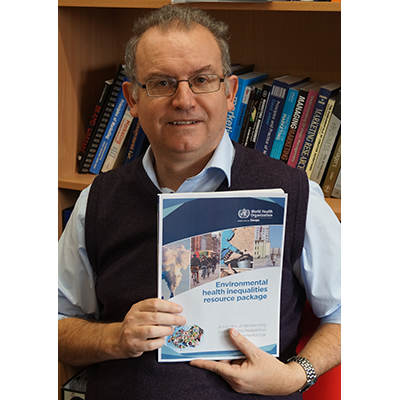Insights from the HBN Seminar on Policy Shifts, Data, and Healthier Populations

The UK's social housing sector is navigating a period of profound transformation. On the 14th May 2025, the Healthy Buildings Network Leeds hosted an insightful online seminar featuring Jon Fairburn and Louise Austin from North West Leicestershire District Council . The discussion, "Trends and policy changes in social housing: Opportunities for healthier populations?", shed light on the complex challenges and significant opportunities facing the sector, emphasising the pivotal role of data and collaboration in shaping healthier futures for residents.

Business Project Manager and Emeritus Professor, North West Leicestershire District Council & University of Staffordshire
Jon leads NWLDC's asset management and retrofit programs, bringing extensive expertise in social housing decarbonisation and regulatory compliance.

Senior Projects and Performance Officer, North West Leicestershire District Council
Louise specialises in housing data management and analysis, working across NWLDC's portfolio of 4,000 homes. Her expertise in leveraging data insights helps drive strategic decision-making and improve tenant outcomes across the district.
Jon Fairburn opened by contextualising the immense pressures on social housing providers. Decades of under-investment, coupled with recent crises, have created a "perfect storm." Key drivers of change include:
These pressures demand a more data-driven and proactive approach to housing management, moving beyond reactive repairs to preventative strategies that enhance resident wellbeing.
Healthier Communities & Environments
Source: Healthy Buildings Network Seminar, Leeds, May 2025
Housing associations are sitting on masses of data, but often lack the capacity and capability to analyse it effectively. Academics, on the other hand, have the expertise but often lack access to such rich, real-world data.
Jon Fairburn
Project Manager, NWLDC
Louise Austin provided a compelling overview of the vast datasets held by housing providers. NWLDC, for instance, manages 4,000 homes and collects extensive data on property characteristics (age of components, construction type, EPC ratings) and tenant demographics (age, vulnerabilities, contact preferences).
"Housing associations are sitting on masses of data," Jon Fairburn reiterated, "but often lack the capacity and capability to analyse it effectively. Academics, on the other hand, have the expertise but often lack access to such rich, real-world data." This gap, he argued, presents a prime opportunity for partnership. Louise Austin added, "We spend so much time firefighting the day-to-day operational problems, we don't always get to see that strategic data analysis to help future problems."
The seminar strongly advocated for synergistic partnerships between universities and housing providers. Such collaborations can unlock significant value:
The speakers shared a briefing paper outlining numerous research ideas for their SHDF Wave 3 project, inviting academics to engage.
Data-rich, resource-constrained
Expertise-rich, data-seeking
Source: Healthy Buildings Network Seminar, Leeds, May 2025
Damp and mould remain a pervasive issue, with NWLDC alone having over 700 open repair orders. Awaab’s Law intensifies the pressure to resolve these swiftly. The seminar explored how data from in-home monitors (like AICO or Switchee devices, which NWLDC is piloting) can provide early warnings and support preventative measures. These monitors can track temperature, humidity, CO2 levels, and even occupancy patterns, offering rich data for analysis.
Other significant challenges discussed included the need to protect vulnerable, ageing populations from issues like overheating – a risk potentially exacerbated by some energy efficiency retrofits if not carefully managed – and the complexities of effective tenant engagement and co-creation of services.
Participants raised critical questions about how data collection and analysis should account for potential disparities in repairs and responses across different resident demographics. Several attendees emphasised the importance of examining the underlying drivers causing poor quality housing, including structural racism.
An important theme emerged around residents being listened to and believed. As one participant who previously served as a CEO in Kensington & Chelsea during the Grenfell Tower fire noted, "It's about the perception of tenants as 'other'." Another attendee observed that "people who aren't listened to aren't counted either," highlighting the compounding effects of marginalization.
Several participants highlighted how the culture within housing organisations significantly affects operations and attitudes toward residents. The discussion acknowledged that variance in outcomes often stems from these cultural differences, with one attendee noting "The cultures are soooo different" between organisations.
The potential for technologies like IoT sensors and Artificial Intelligence (AI) was a recurring theme. While still nascent in the housing sector, AI could be a "game changer" for spotting trends in repairs, improving regulatory reporting, informing decisions, and even predicting tenant health needs. The rich datasets held by housing providers are ideal training grounds for AI models, provided ethical considerations and data governance are robustly addressed.
The seminar concluded with a powerful message: the challenges facing social housing are immense, but so are the opportunities for positive change. By fostering strong, collaborative relationships between those on the frontline of housing provision and the research community, we can unlock innovative solutions.
The Healthy Buildings Network Leeds is committed to being a catalyst for these collaborations. We aim to bridge the gap between theory and practice, ensuring that research translates into tangible improvements in the health, safety, and wellbeing of residents in social housing across the UK.
We invite researchers, housing professionals, policymakers, and community advocates to connect with us. Let's work together to build a future where every home is a healthy home.

Director, Healthy Buildings Network Leeds & Water, Public Health & Environmental Engineering Research Group, University of Leeds
Dr. King leads interdisciplinary research at the intersection of building engineering, public health, and data science. He is passionate about supporting collaborations to create healthier and more sustainable built environments for all.
Exploring how data analytics can transform housing services and improve tenant outcomes.
Strategies for prevention, remediation, and policy changes to combat damp and mould in residential properties.
How academic collaborations are helping to solve real-world housing challenges.